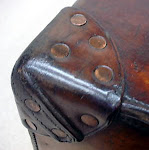Crocodile and snake skin restoration
Reptile skin is both resilient and hard wearing. The problems occur when it is allowed to dry out. Once again, before starting any kind of repair work, feed the leather with a little Skidmores Restoration Cream rubbed in with your fingertips until it becomes supple. It make take several applications before the leather has enough elasticity to handle being sewn.
Never try to force a sharp needle through reptile skin as it will often split. use a very sharp awl to prick holes through the skin and then follow the awl with a blunt needle and thread before the hole closes again.
Cleaning 1940s crocodile or snake skin
Reptile skin that is very dusty or dirty needs to be cleaned before restoration cream is applied. Vaccum away dust and surface dirt and carefully clean the skin with a soft brush and little warm water and saddle soap followed by a good quality liquid leather conditioner like Lexol. Make sure all the saddle soap is rinsed off and the leather is completely clean before spraying lightly with Lexol. Allow the Lexol to soak in and dry then finish off with Skidmore's Restoration Cream to seal the surface again.
Note: Do not use detergents as these strip any remaining oils from the skin.
Cleaning kid gloves:
Light coloured kid gloves can be cleaned by rubbing with a piece of soft white India rubber. Clean the rubber on blotting paper as it becomes soiled.
A 1940s trick was to wash very soiled light coloured gloves in a basin of petrol. Soak the whole glove in the basin for a few minutes to loosen the dirt. . Take a small piece of white flannel and rub the fingers and dirty parts carefully. Then rub the gloves lightly with the hands with an ordinary washing movement, and wring them out carefully. The cleaned gloves should then be pulled gently into shape and hung out to dry in the fresh air. The smell should vanish in a few days.
To clean coloured leather gloves, mix together equal quantities of fuller’s earth and powdered alum, and rub the gloves all over with the mixture. Leave for two hours, then brush thoroughly to get rid of the powder.
Restoration problems:
The main problems you will face are crumbling leather and splitting holes. If this becomes an issue then work a little Skidmore's Restoration Cream into the leather and leave it overnight to soak in. The following day you may find the leather has enough elasticity for you to proceed with your repair. If not then you may need to contemplate asking a leatherworker to fit a neat patch over the damaged area.
For more information contact:
Reptile skin is both resilient and hard wearing. The problems occur when it is allowed to dry out. Once again, before starting any kind of repair work, feed the leather with a little Skidmores Restoration Cream rubbed in with your fingertips until it becomes supple. It make take several applications before the leather has enough elasticity to handle being sewn.
Never try to force a sharp needle through reptile skin as it will often split. use a very sharp awl to prick holes through the skin and then follow the awl with a blunt needle and thread before the hole closes again.
Cleaning 1940s crocodile or snake skin
Reptile skin that is very dusty or dirty needs to be cleaned before restoration cream is applied. Vaccum away dust and surface dirt and carefully clean the skin with a soft brush and little warm water and saddle soap followed by a good quality liquid leather conditioner like Lexol. Make sure all the saddle soap is rinsed off and the leather is completely clean before spraying lightly with Lexol. Allow the Lexol to soak in and dry then finish off with Skidmore's Restoration Cream to seal the surface again.
Note: Do not use detergents as these strip any remaining oils from the skin.
Cleaning kid gloves:
Light coloured kid gloves can be cleaned by rubbing with a piece of soft white India rubber. Clean the rubber on blotting paper as it becomes soiled.
A 1940s trick was to wash very soiled light coloured gloves in a basin of petrol. Soak the whole glove in the basin for a few minutes to loosen the dirt. . Take a small piece of white flannel and rub the fingers and dirty parts carefully. Then rub the gloves lightly with the hands with an ordinary washing movement, and wring them out carefully. The cleaned gloves should then be pulled gently into shape and hung out to dry in the fresh air. The smell should vanish in a few days.
To clean coloured leather gloves, mix together equal quantities of fuller’s earth and powdered alum, and rub the gloves all over with the mixture. Leave for two hours, then brush thoroughly to get rid of the powder.
Restoration problems:
The main problems you will face are crumbling leather and splitting holes. If this becomes an issue then work a little Skidmore's Restoration Cream into the leather and leave it overnight to soak in. The following day you may find the leather has enough elasticity for you to proceed with your repair. If not then you may need to contemplate asking a leatherworker to fit a neat patch over the damaged area.
For more information contact:
Barefoot Leather of Ludlow, Shropshire.
Don't worry if you don't live close by - we are very fond of Jiffy Bags and Postman Pat!






No comments:
Post a Comment